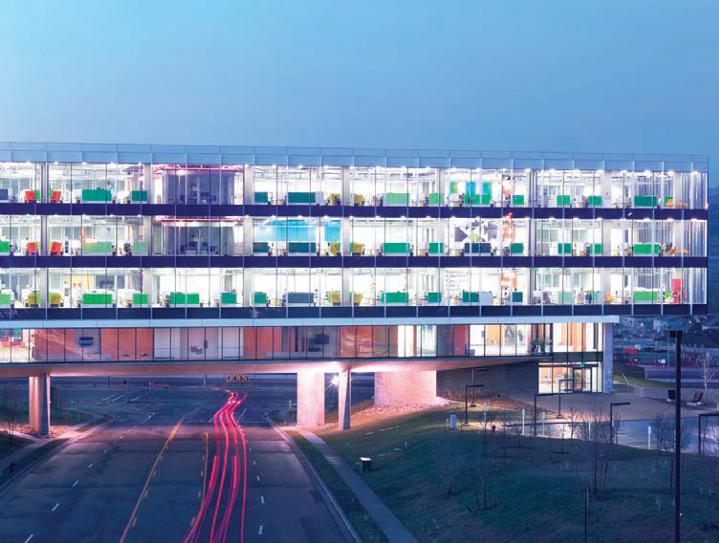A new study that puts the spotlight on technology and innovations indicates that it shines on Utah as well as better-known areas.
The Information Technology and Innovation Foundation (ITIF) report shows that high-tech innovation plays a critical role in the economy in all four of Utah’s congressional districts.
ITIF, a U.S. think tank for science and technology policy, examined 20 indicators of the innovation-driven high-tech economy, looking at both traditional economic data such as technology exports and newer metrics such as broadband deployment. That examination was used to form statistical portraits of all 435 U.S. congressional districts, 50 states, and the District of Columbia. It found a nation in which the drivers of high-tech innovation are widely diffused.
“The myopic view that the high-tech economy is only Silicon Valley and a few other bright spots like Boston or North Carolina’s Research Triangle is flat wrong,” said Robert D. Atkinson, ITIF’s president. “Indeed, all districts in Utah have some kind of tech-driven activity occurring locally. This should serve as a signal to every member of Congress from Utah and the rest of the country that tech matters to their states and districts, so they should support broad-based, bipartisan policies to spur further innovation and growth at home and across the nation.”
The report lists well-known tech centers — the Route 128 tech corridor around Boston; Research Triangle Park in Raleigh, Durham and Chapel Hill, North Carolina; Austin, Texas; Seattle; and Silicon Valley — but indicates that innovation is taking place across a broad area of the nation. “This has always been too myopic a view of how innovation is distributed across the country, because many other metropolitan areas and regions — from Phoenix to Salt Lake City to Philadelphia — are innovative hot spots, too, and many more areas are developing tech capabilities,” it says.
As a state, Utah ranked in the top 10 in high-tech share of total workforce (No. 6, at 10.9 percent), computer and math share of STEM (science, technology, engineering and math) workers (No. 8, at 55.4 percent) and the average number of broadband providers per household, (No. 7 at 7.49).
Utah congressional districts also were ranked in the top 50 nationally in several categories:
• IT services exports, Utah’s 3rd District, No. 48, at $161 million.
• Royalty and license services exports, 3rd District, No. 39, at $645 million.
• Royalty and license share of all services exports, 3rd District, No. 36, at 34.4 percent.
• High-tech sector workers, 4th District, No. 45, with 51,200.
• High-tech share of total workforce, 4th District, No. 43, at 14.1 percent.
• Computer and math share of STEM workers, 3rd District, No. 34, at 62.6 percent; and 4th District, No. 44, at 61.8 percent.
The report is available at itif.org/technation.
“The country’s innovation-driven, high-tech economy really is much more widely diffused than most people imagine,” Atkinson said. “We urge members of Congress and other policymakers to find common cause in advancing an agenda that continues to build up the foundations of an innovation-driven economy, including a highly skilled workforce, robust research and development spending, digital-age infrastructure, and globally competitive tech-driven industries. It’s the surest way to raise productivity, bolster competitiveness and boost wages.”
Other rankings for Utah included:
• No. 25 for high-tech manufacturing exports, $3.4 billion.
• No. 23 for high-tech share of all manufacturing exports, 29.4 percent.
• No. 22 for IT services exports, $279 million.
• No. 18 for IT share of all services exports, 4.4 percent.
• No. 21 for royalty and license services exports, $1.34 billion.
• No. 12 for royalty and license share of all services exports, 21 percent.
• No. 24 for total number of high-tech sector workers, 148,253.
• No. 27 for total number of STEM workers, 80,695.
• No. 14 for STEM share of total workforce, 5.9 percent.
• No. 25 for total number of computer and math workers, 44,745.
• No. 33 for number of highly educated immigrant workers, 15,568.
• No. 29 for immigrant share of highly educated workers (as a share of all workers with a graduate or professional degree), 9.3 percent.
• No. 15 for patent filers per 1,000 workers who filed a utility patent from 2012-15, 9.6.
• No. 14 for patents filed per 1,000 workers in 2012-15, 3.8.
• No. 22 for public research and development funding per worker in 2014-15, $722.
• No. 12 for percentage of households with 25Mbps broadband coverage, 93.9 percent.
• No. 34 for percentage of households with 10Mbps broadband coverage, 98.5 percent.








